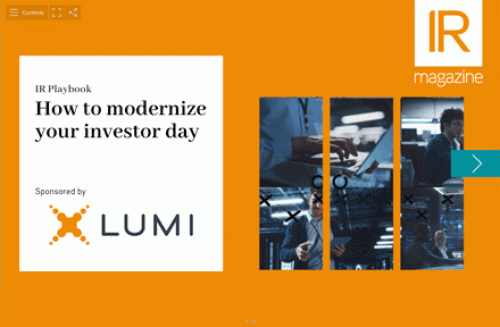Investor days are widely cited as one of most impactful event formats in an IRO’s arsenal. But the logistical undertaking required – particularly in a post-pandemic world where some investors would prefer an in-person gathering, others virtual – can be significant, and the road to putting on an investor day can be long and winding.
In 2024, there are new tools, techniques and innovative methods of delivering a high-impact investor day to your stakeholders. A recent IR Magazine Webinar sought the advice of Stephanie Corrente, director of corporate communications at Stella-Jones, a Canadian manufacturer of pressure-treated wood products that earlier this year scooped the award for best investor event at the IR Magazine Awards – Canada.
Alongside Sylvie Harton, chief business strategy officer at meetings platform provider Lumi, Corrente discussed exactly what goes into putting on an award-winning investor day. Below are their key takeaways to help other IROs plan their own high-impact events.
Find your North Star
For Corrente, the obvious focus should be on communicating your organization’s key message, taking in how it impacts the company’s vision, strategy, financial performance and outlook. ‘The core of the event is really landing on a narrative you want to convey and building out a robust content strategy around that, defining your speakers, your agenda and ultimately the experience around that,’ she explained. ‘This accomplishes a number of things that ensure consistency in your message, transparency and – frankly – honest communication.’
Horton agreed, saying organizations that put on the best investor days are ‘very intentional about what they’re trying to [do]’ and making that’s the core focus of the event. ‘That becomes a North Star in terms of what success looks like; it becomes the measure of success at the end of the investor day,’ she explained.
Consider access
Aside from that message, both panelists reiterated that an investor day is a great opportunity to give your audience access – not just to your company, but also to your products and internal leaders. Corrente said planning which sort of engagement guests would have with both executives and the company’s treated-wood products was crucial to maximizing the day’s impact, whether during networking opportunities, open communication sessions or even the Q&A. She and the team brought in experts across product categories to speak about Stella-Jones’ offering in more depth.
‘Showcasing the extent of our leadership team and the knowledge that goes into operating our business every day was a very important objective for us,’ Corrente explained. ‘We also wanted to provide a bit of an incursion into our world in a way that doesn’t always come across in regular communication channels.’
Doing hybrid well
Striking a balance between in-person and virtual attendees is crucial, Horton and Corrente agreed. Part of that can be achieved by ensuring that assets are consistent across either experience so that the story can be told in the same way to either audience.
Horton praised Corrente’s use of ‘visual communication’ throughout that prioritized ‘inclusivity and accessibility’. This included having a showtime that catered for a broad range of time zones and real-time translation and closed captioning for foreign viewers, alongside making sure that Q&As addressed queries from both virtual and in-person audiences. Using a trusted technology provider is crucial here, both panelists agreed, and Corrente added that a bonus of taking this approach is that it provides a clear channel for retail investors to participate.
Remaining agile on the day
Corrente revealed that the planning effort behind Stella-Jones’ investor day was significant, but that it also set her up to remain light on her feet when the event came along.
‘You want to make sure you set yourself up for success… making sure you have a robust schedule, that accountabilities are properly mapped out, regular touch points are scheduled and the content is developed,’ she said. ‘You have to plan for flexibility and adaptability – and that’s also a very frank conversation you have to have with your team: to prepare for the unexpected and pivot should anything go awry.’
To view an on-demand version of this webinar on BrightTALK, please click here.










